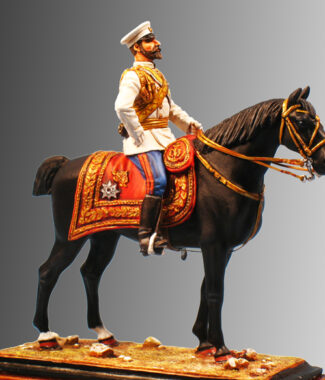You must be logged in to post a review.
MEHMED V SULTAN OF THE OTTOMAN EMPIRE (1844-1918)
€68.00
Figura para montar y pintar
Ref.: 09 – KI
Peso: 250 grs.
Material: White Metal
Numero de Piezas: 18
Reseña Histórica:
Sultán otomano. Nació en Constantinopla el 2 de noviembre de 1844 y murió en la misma ciudad el 3 de julio de 1918. Fue sultán del Imperio otomano entre 1909 y 1918. Su verdadero nombre era Reshid Effendi.
Ottoman sultan. He was born in Constantinople on November 2, 1844 and died in the same city on July 3, 1918. He was Sultan of the Ottoman Empire between 1909 and 1918. His real name was Reshid Effendi.
He was the son of Sultan Abdul Mecid I. He was imprisoned by his brother Sultan Abdul Hamid II for thirty-three years, since the latter feared that he could take power away from him. He succeeded his brother, after the latter had been deposed, in 1909. His contemporaries described them as an affable and polite man. He had been schooled in Islamic subjects, in the Ottoman tradition, and in Turkish and Persian literatures. He developed an intense interest in Ottoman and Islamic history.
He was a puppet ruler, as his government was controlled by the Young Turk movement. Young Turks is the nickname of an early 20th century Turkish nationalist and reformist party, officially known as the Committee of Union and Progress (CUP), whose leaders rebelled against Sultan Abdul Hamid II, who was officially deposed and banished in 1909. They ruled the Ottoman Empire between mid-1908 and the end of World War I in November 1918 when the occupation of Constantinople saw the partition of the Ottoman Empire.
During their rule, they perpetrated the Armenian genocide and are blamed for promoting persecutions and massacres against Greeks in Anatolia between 1915 and 1923, during which time it is estimated that at least 1.5 million Armenians perished. The Young Turks had their origins in secret societies of university students and military cadets, surreptitiously driven by political dissent after the constitution was revoked by Sultan Abdul Hamid II.
The Committee of Union and Progress had elevated him to the throne after deposing his brother. His lack of character caused him to become a mere figurehead. The sultan tried to give the appearance of being a constitutional monarch, but he was all appearances. At the request of the Committee of Union and Progress he made a goodwill trip to Thrace and Albania, to appease the independence movements.
His reign was characterized by the territorial losses of the Ottoman Empire. Italy occupied Tripolitania, Cyrenaica and the Dodecanese in 1912, and after the First Balkan War (1912-1913), it lost Macedonia, Thrace, Thessaloniki and Crete. In the First World War he was opposed to Turkey aligning itself with the Central Powers, a decision that the government had adopted. As caliph he was forced to declare the Holy War and invited all Muslims, especially those who were dominated by the allies, to support the Ottoman Empire. He died in the course of World War I, when most of the Ottoman territory was in Allied hands.
The figure is represented in the visit that the sultan made on the first day of Ramadan to the great mosque in Istanbul. He is dressed in civilian clothes and rides a beautifully embroidered horse.








Reviews
There are no reviews yet.